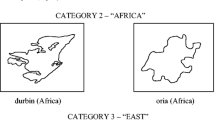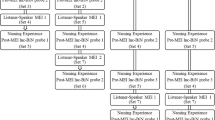Abstract
The phenomenon identified as naming is a key stage of language function that is missing in many children with autism and other language delay diagnoses. We identified four children with autism, who, prior to the implementation of this experiment, did not have the naming repertoire (either speaker to listener or listener to speaker) and who had no tact responses for two- or three-dimensional stimuli. Tact training alone did not result in a naming repertoire or echoic-to-tact responses for these students. We then provided multiple exemplar instruction (MEI) across speaker and listener repertoires for a subset of stimuli (the teaching set) that resulted in untaught response components of naming and the capability to acquire naming after learning tacts for subsequent sets of stimuli. We used a delayed multiple-baseline probe design with stimuli counterbalanced across participants. The results showed that for all four students, mastery of tacts alone (the baseline or initial training condition) was not sufficient for the naming or echoic-to-tact repertoires to emerge. Following MEI the naming repertoire emerged for all four students for the initial set of stimuli. In addition, we tested for naming with novel stimuli that were probed prior to the MEI and naming also emerged following tact instruction alone for these sets. The results are discussed in terms of the role of naming in the incidental acquisition of verbal functions as part of the speaker-as-own-listener repertoire.
Similar content being viewed by others
References
Becker, B. J. (1989). The effect of mands and tacts on conversational units and other verbal operants. (Doctoral dissertation, 1989, Columbia University). Abstract from UMI Proquest Digital Dissertations [on-line]. Dissertations Abstracts Item: AAT 8913097.
Catania, C. A. (1998). Learning. Upper Saddle River, NJ: Prentice-Hall.
Chu, H. C. (1998). A comparison of verbal behavior and social skills approaches for development of social interaction skills and concurrent reduction of aberrant behaviors of children with developmental disabilities in the context of the matching theory. (Doctoral dissertation, 1998, Columbia University). Abstract from UMI Proquest Digital Dissertations [on-line]. Dissertations Abstracts Item: AAT 9838900.
Cuvo, A. J. (2003). On stimulus generalization and stimulus classes. Journal of Behavioral Education, 12, 77–83.
Gilic, L. (2005). The development of naming in two-year old children. Unpublished doctoral dissertation, Columbia University, NY.
Greer, R. D. (1992). Teaching Operations for Verbal Behavior. Unpublished manuscript.
Greer, R. D. (2002). Designing Teaching Strategies: An Applied Behavior Analysis Systems Approach. San Diego, CA: Academic Press.
Greer, R. D., & Keohane, D. D. (2005). The evolution of verbal development in young children. Behavior Development Bulletin, it1, 31–48.
Greer, R. D., & McDonough, S. H. (1999). Is the learn unit a functional measure of pedagogy? The Behavior Analyst, 22, 5–16.
Greer, R. D., Nirgudkar, A., & Park, H. (2003). The effect of multiple exemplar instruction on the transformation of mand and tact functions. Paper presented at the International Conference of the Association for Behavior Analysis, San Francisco, CA.
Greer, R. D., & Ross, D. E. (2004). Research in the induction and expansion of complex verbal behavior. Journal of Early Intensive Behavioral Intervention, 1(2), 141–165. http://www.jeibi.com/JEIBI-I-2.pdf.
Greer, R. D., Stolfi, L., Chavez-Brown, M., & Rivera-Valdez, C. (2005). The emergence of the listener to speaker component of naming in children as a function of multiple exemplar instruction. The Analysis of Verbal Behavior, 21, 123–134.
Greer, R. D., Yuan, L., & Gautreaux, G. (2005). Novel dictation and intraverbal responses as a function of a multiple exemplar instructional histories. The Analysis of Verbal Behavior, 21, 99–116.
Hayes, S. C., Barnes-Holmes, D., & Roche, B. (2001). Relational frame theory: A post-Skinnerian account of human language and cognition. New York: Kluwer/Academic Plenum.
Horne, P. J. & Lowe, C. F. (1996). On the origins of naming and other symbolic behavior. Journal of the Experimental Analysis of Behavior, 65, 185–241.
Horne, P. J., Lowe, C. F., & Randle, V. R. L. (2004). Naming and categorization in young children: II. Listener behavior training. Journal of the Experimental Analysis of Behavior, 81, 267–288.
Horner, R. D., & Baer, D. M. (1978). Multipleprobe technique: A variation on the multiple baseline. Journal of Applied Behavior Analysis, 11, 189–196.
Karmali, I., Greer, R. D., Nuzzolo-Gomez, R., Ross, D.E., & Rivera-Valdes, C. (2005). Reducing palilalia by presenting tact corrections to young children with autism. The Analysis of Verbal Behavior, 21, 145–154.
Lamarre, J. & Holland, J. G. (1985). The functional independence of mands and tacts. Journal of the Experimental Analysis of Behavior, 43, 5–19.
Lodhi, S., & Greer, R. D. (1989). The speaker as listener. Journal of the Experimental Analysis of Behavior, 51, 353–359.
Lowe, C. F., Horne, P. J., Harris, F. D. A., & Randle, V. R. L. (2002). Naming and categorization in young children: Vocal tact training. Journal of the Experimental Analysis of Behavior, 78, 527–549.
Marianno-Lapidus, S. (2005). (Doctoral dissertation, 2005, Columbia University). Abstract from: UMI Proquest Digital Dissertations [on-line]. Dissertations Abstracts Item.
Michael, J. (1982). Skinner’s elementary verbal relations: Some new categories. The Analysis of Verbal Behavior, 1, 1–3.
Nuzzolo-Gomez, R., & Greer, R. D. (2004). Emergence of untaught mand or tacts with novel adjective-object pairs as a function of instructional history. The Analysis of Verbal Behavior, 24, 30–47.
Paniagua, F. A., & Baer, D. M. (1982). The analysis of correspondence training as a chain reinforceable at any point. Child Development, 53, 786–798.
Pinker, S. (1999). Words and rules. New York: Perennial.
Ross, D. E. & Greer, R. D. (2003). Generalized imitation and the mand: Inducing first instances of speech in young children with autism. Research in Developmental Disabilities, 24, 58–74.
Skinner, B. F. (1957). Verbal Behavior. Acton, MA: Prentice-Hall.
Speckman, J. (2005). (Doctoral dissertation, 2005, Columbia University). Abstract from: UMI Proquest Digital Dissertations [online]. Dissertations Abstracts Item: AAT 3159757.
Sundberg, M. L., Michael, J., Partington, J. W., & Sundberg, C. A. (1996). The role of automatic reinforcement in early language acquisition. The Analysis of Verbal Behavior, 13, 21–37.
Tsiouri, I., & Greer, R. D. (2003). Inducing vocal verbal behavior through rapid motor imitation responding in children with severe language delays. Journal of Behavioral Education, 12(3), 185–206.
Twyman, J. S. (1996a). An analysis of functional independence within and between secondary verbal operants. (Doctoral dissertation, 1996, Columbia University). Abstract from: UMI Proquest Digital Dissertations [on-line]. Dissertations Abstracts Item: AAT9631793.
Twyman, J. S. (1996b). The functional inde pendence of impure mands and tacts of abstract stimulus properties. The Analysis of Verbal Behavior, 13, 1–19.
Williams, G., & Greer, R. D. (1993). A comparison of verbal-behavior and linguisticcommunication curricula for training developmentally delayed adolescents to acquire and maintain vocal speech. Behaviorology, 1, 31–46.
Yoon, S. Y. (1998). Effects of an adult’s vocal sound paired with a reinforcing event on the subsequent acquisition of mand functions. (Doctoral dissertation, 1998, Columbia University). Abstract from: UMI Proquest Digital Dissertations [on-line]. Dissertations Abstracts Item: AAT9839031.
Author information
Authors and Affiliations
Corresponding author
Additional information
The research reported herein was completed as part of a Ph.D. dissertation by the first author under the sponsorship of the second author.
Rights and permissions
About this article
Cite this article
Fiorile, C.A., Greer, R.D. The Induction of Naming in Children with No Prior Tact Responses as a Function of Multiple Exemplar Histories of Instruction. Analysis Verbal Behav 23, 71–87 (2007). https://doi.org/10.1007/BF03393048
Published:
Issue Date:
DOI: https://doi.org/10.1007/BF03393048




